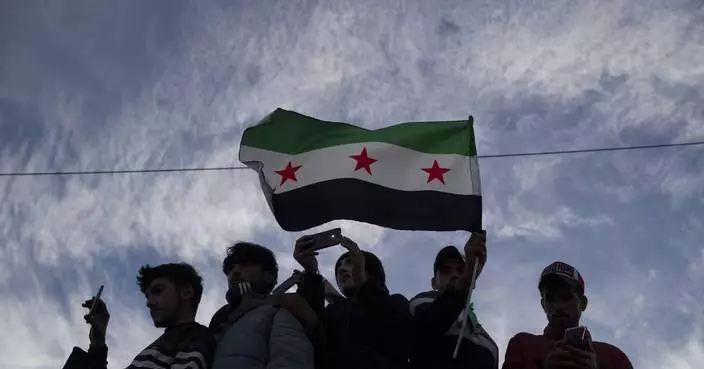As the newly-named host of the 2034 World Cup in men's soccer, Saudi Arabia says it will construct or renovate 15 stadiums, create a futuristic city and expand airports in a massive buildout to accommodate millions of athletes, coaches and spectators.
That will emit tons of planet-warming greenhouse gases as concrete and steel are manufactured and transported, diesel-powered excavators and trucks are used and new buildings are powered and cooled. When all the emissions associated with the world's buildings are grouped together, they are the largest contributor to climate change.
Constructing so many new venues is “environmentally wasteful in the extreme” because so much carbon will be emitted and scarce resources used, said Andrew Zimbalist, an economics professor at Smith College in Massachusetts who has written several books about the economics of mega sporting events. Zimbalist said the World Cup should be held in countries with a developed soccer culture and industry.
Seth Warren Rose, founding director of the research organization Eneref Institute, said the world will be even hotter a decade from now, and can’t afford this added warming.
“I’m sorry, but we’re living in a different planet. We have to prepare for that,” Rose said. “By 2034, we’ll be living in a different climate and that’s not a metaphor."
Rose said his message to organizers is: Make a genuine effort to reduce emissions or don't host at all.
Saudi Arabia’s plans will rely heavily on concrete, which is responsible for about 8% of worldwide emissions that warm the planet, with iron and steel accounting for another 7%. Human rights groups are concerned that giving the 2034 World Cup to Saudi Arabia will endanger migrant workers.
In a bid book detailing its plans for development across five cities ahead of the World Cup, Saudi Arabia said three new stadiums are currently under construction and eight more are planned, to accommodate 2034's first-ever 48-team games. Buildings constructed for international sporting events often end up becoming “white elephant” venues that sit idle once games are over. The Saudi Arabian Football Federation did not respond to request for comment.
Saudi Arabia has proposed 134 accommodations for teams and referees, new hotels, several fan festival locations, transportation expansions, including high-speed rail and further investment in its futuristic city of Neom. Much of what the nation included in its bid book relates to its Vision 2030 strategic plan, which the government calls a plan to diversify its economy and unlock new business opportunities.
The bid does include sustainability initiatives, said Karim Elgendy, a fellow at London’s Chatham House think tank. Among them are running stadiums on clean electricity such as solar, using energy-efficient natural ventilation and shading and mandating green building standards.
But Elgendy said the sheer scale of Saudi Arabia's apparent plans for the event, plus the distances between host cities suggest this could become the most carbon-intensive World Cup in history. Elgendy said how they mitigate this undertaking will determine the environmental impact and without measures, the event could have a carbon footprint that is almost twice the record set in 2022.
To critics who suggest FIFA ought to have chosen a different host country, like the United Kingdom which has dozens of stadiums, Walker Ross, a researcher of sport ecology and sustainability at the University of Edinburgh points out the Saudi bid was the only one in a fast-tracked process.
The next World Cup, in 2026, will span 16 cities across North America. Ross said that could have a significant carbon footprint, too, as teams and fans travel across an entire continent. The same could be said for the 2030 World Cup to be played across six countries. If anyone is at fault, it's FIFA, he said, because it's their bid process.
“People kind of throw their hands up in the air and act like there are certain countries that should and shouldn’t host when it comes to these events,” he said. “But if this sport is truly for the world, then we have to be open to everyone hosting.”
Qatar went on a $200 billion construction spree, building seven stadiums, a new metro system, highways, high-rise buildings and a futuristic city ahead of the 2022 event there. Organizers and FIFA projected it would produce some 3.6 million metric tons of carbon dioxide over the decade spent preparing for the tournament, or about 3% of Qatar’s total emissions in 2019, according to World Bank data. Experts say the Qatar event had the highest carbon emissions to date.
Skeptics and outside experts said Qatar’s accounting that it hosted a ‘carbon neutral’ World Cup didn't encompass the event’s full carbon footprint.
In contrast, organizers of this summer’s Paris Olympics said this week they met their goal of cutting the games’ carbon footprint by half compared to 2012 and 2016. They did this using renewable energy, recycled materials, plant-based food options that are less carbon-intensive than meat and even powering the famous Olympic cauldron with electricity and lights rather than burning gas.
FIFA accepted Saudi Arabia’s sustainability and climate promises in an evaluation released in November, noting that “whilst the extent of construction would have a material environmental impact, the bid provides a good foundation for delivering mitigation measures to address some of the environment-related challenges.”
FIFA directed The Associated Press to the evaluation Thursday when asked for additional comment.
Saudi Arabia's emissions have been growing; it emitted 533 metric tons of carbon dioxide in 2022, or 1.6% of global emissions, according to the International Energy Agency, and its fossil fuel production is skyrocketing. Renewable energy remains nearly nonexistent, though the country has a goal to source at least half of its power from renewables by 2030.
Read more of AP’s climate coverage at http://www.apnews.com/climate-and-environment
The Associated Press’ climate and environmental coverage receives financial support from multiple private foundations. AP is solely responsible for all content. Find AP’s standards for working with philanthropies, a list of supporters and funded coverage areas at AP.org.

FILE - People gather at the King Abdullah Sports City stadium prior to the Soccer Club World Cup match between Al-Ittihad and Auckland City in Jeddah, Saudi Arabia, Dec. 12, 2023. (AP Photo/Manu Fernandez, File)

FILE - The trophy is displayed on the pitch ahead of the World Cup final soccer match between Argentina and France at the Lusail Stadium in Lusail, Qatar, Dec. 18, 2022. (AP Photo/Martin Meissner, File)

FILE - Saudi Arabia fans support their team during the Asian Cup Round of 16 soccer match between Saudi Arabia and South Korea, at the Education City Stadium in Al Rayyan, Qatar, Jan. 30, 2024. (AP Photo/Thanassis Stavrakis, File)

FILE - The King Abdullah sports city stadium stands in Jiddah, Saudi Arabia, Saturday, Jan. 11, 2020, on the eve of the Spanish Super Cup Final soccer match between Real Madrid and Atletico Madrid. (AP Photo/Hassan Ammar, File)

FILE - A map at the Saudi Arabia World Cup bid exhibition in Riyadh, Saudi Arabia, Wednesday Dec. 11, 2024, shows the proposed host cities and venues for the 2034 World Cup. (AP Photo/Baraa Anwer, File)

FILE - A detailed model of Riyadh's proposed sports infrastructure is on display at the Saudi Arabia World Cup bid exhibition in Riyadh, Saudi Arabia, Dec. 11, 2024. The exhibition highlights the Kingdom's plans for hosting the 2034 World Cup. (AP Photo/Baraa Anwer, File)




















